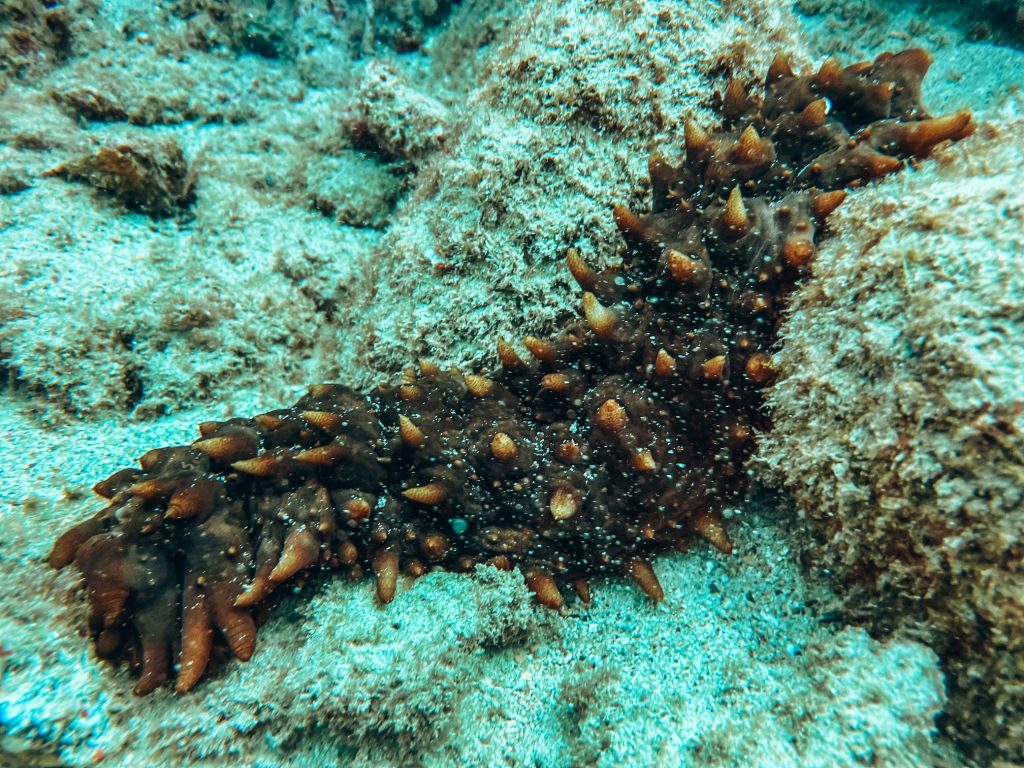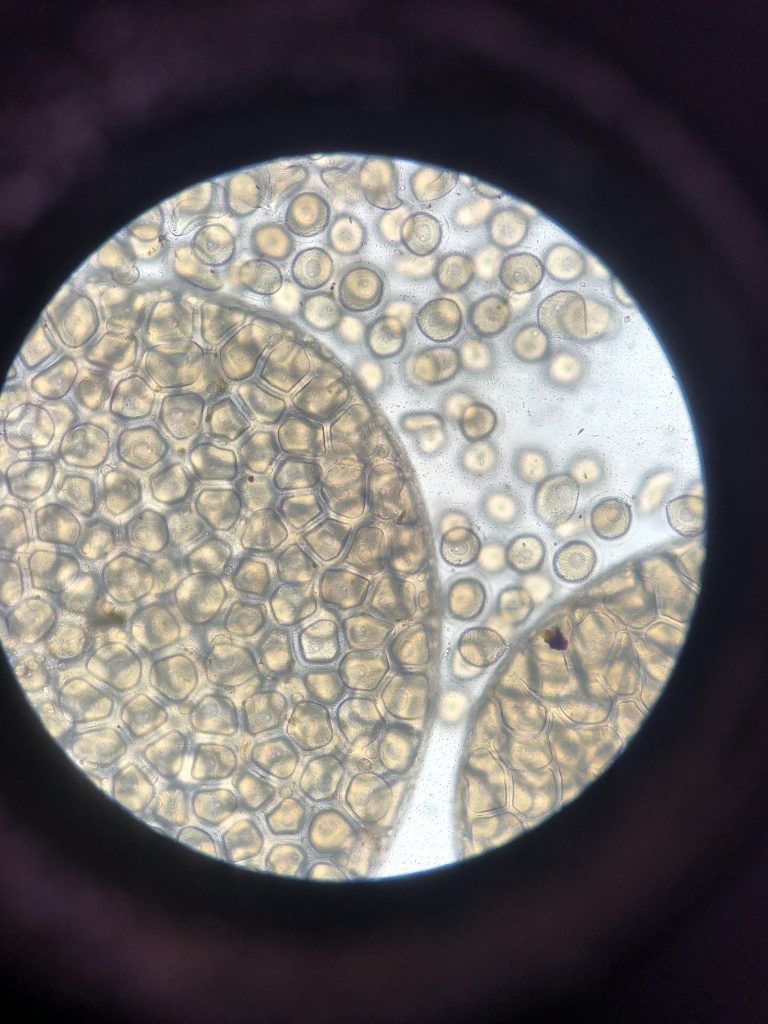Kauaʻi Sea Farm cultivating loli for export and fishpond restoration with NOAA funding

With the full moon still hung low in the sky, Tim Leichliter jumped into the ocean off Kaumakani on Kaua‘i’s South Shore and swam in a circle. He was searching for a submerged mooring about 10 feet below the surface.
Fighting a slight current and the rising sun’s glare, he found the mooring and dove down with a line used to secure the twin-engine outboard in place.
Now the real work could begin: collecting sexually-mature loli, also known as Hawaiian sea cucumbers.
Leichliter and Dave Anderson are personnel at Kaua‘i Sea Farm, a commercial aquaculture business at the ancient Nomilo fishpond in Kalāheo. The farm has partnered with the O‘ahu nonprofit Pacific American Foundation to cultivate loli as a high-value export product.
The project, which will primarily feed Chinese and Japanese culinary and medicinal markets, is
funded by a nearly $300,000 Saltonstall-Kennedy grant from the National Oceanic and Atmospheric Administration. If successful, the two-year initiative will establish a new revenue stream for fishponds throughout Hawai‘i.
“Generally speaking, sea cucumbers around the world are extremely overexploited, especially
the species we’re working with,” Anderson said.
Some species are worth a few thousand dollars per kilo (2.2 pounds). Others, like the species handled at Kaua‘i Sea Farm, are worth between $200 and $400 per kilo.
In Asian countries, sea cucumbers are considered a delicacy. They are dried and used in soups and other dishes. In traditional Chinese medicine, sea cucumbers are used to treat fatigue, impotence, constipation, frequent urination and joint pain, according to Memorial Sloan Kettering Cancer Center.
Sea cucumbers are high in protein and possess vital vitamins, minerals and antioxidants that provide important health benefits. The vital vitamins include riboflavin, which helps with energy production and metabolism, and magnesium, which helps the heart beat and bones grow, according to WebMD.
“There are a lot of aquaculture projects around the world that are popping up to try and jump
into this market, because it keeps growing and growing and growing,” Anderson continued. “But the U.S. is not really doing anything in the market.”
The work underway on Kaua‘i could change that.
Anderson believes sea cucumbers represent a unique opportunity for Hawai‘i, where the
animals naturally occur. They can be used as restorers of traditional fishponds that have bottoms often filled with broken-down fish waste, leaf matter and other organic matter.
These “junk” beds of extra nutrients, which wouldn’t otherwise cycle through the ponds’
ecosystems, are an excellent source of food for sea cucumbers.
“A lot of that’s just from not being in use for 30 years, sometimes hundreds of years,” he said.
“Sea cucumbers are this rare opportunity where they have a net benefit to the environment at
the pond, and they’re also a desirable marketable product.”
The NOAA project officially covers three species of loli. But on Monday, Anderson and Leichliter were looking for a fourth. That’s because the surf redfish (Actinopyga varians), black teatfish (Holothuria whitmaei) and namako (Stichopus horrens), all native to Hawai‘i, have proven difficult to spawn in captivity by the sea farm.
Anderson said this development isn’t necessarily a surprise, considering the project is in uncharted waters.
“There’s research for some of these species in different parts of the world, but nothing in Hawai‘i or anywhere that’s even the same latitude,” he said.
The Kaua‘i Sea Farm team is still working to spawn white teatfish and namako, although they’ve
replaced the less-valuable and abundant surf redfish with another native species, the Hawaiian
spiky cucumber. This cucumber has not been formally described by scientists, who informally refer to them as “Stichopus species No. 1”.
“As far as an endemic species goes, I think it’s probably in the endangered category, but just
not well-surveyed enough to know,” Leichliter said. “It’s the less-common species I think we want to focus on, to take some of that pressure off of the wild.”
The NOAA project seeks to establish sustainable practices for farm-raised loli in Hawai‘i.
Leichliter said he has seen the dark side of the international wild-caught fishery first-hand.
Years ago, as a hotel manager in Fiji, he watched fishers drag rakes across delicate coral
ecosystems to capture as many sea cucumbers as possible.
“It’s people with big money that know that they can manipulate small island nations,” he said. “They offer them money that they have never even fathomed was possible, to deplete ecosystems that have sustained their populations for years.
“The Fijians were making about $2 Fijian an hour. That’s about $1 U.S. an hour … These
Chinese fishermen would come to the villages and say ‘Hey, we’ll pay you 15 Fiji dollars per sea
cucumber. Go out and collect everything you can.’”
Equipped in scuba gear, Anderson and Leichliter were prepared to search for Hawaiian spiky sea cucumbers on Monday a week ago. They chose the date carefully: The species has been seen spawning in coordination with the full moon. The two men hoped to collect six specimens ready to reproduce.
Just before diving into the water, Anderson said: “We’re not trying to take all of the stock. We’re just trying to get them so we can get some of their gametes (mature male or female germ cells) to hopefully reproduce them. Then we’ll put them back into the wild because we understand their conservation status.”
Anderson and Leichliter back-rolled into the ocean, descended 45 feet to the reef and almost immediately spotted a large Hawaiian spiky cucumber. Anderson gently scooped the
rust-colored animal into a collection bag and the search resumed with Leichliter in the lead.
Kihikihi pecked among the seabed’s rubble, their ribbon-like fins fluttering like flags in a gentle breeze. Schools of other fishes flashed in the waters above. Vibrant clusters of coral punctuated the dim reef below.
Yet, despite the natural beauty on display, Anderson and Leichliter’s fortunes had seemingly
turned for the worse. The water’s relatively-low visibility made their work difficult and Leichliter
could find no more loli, even as he took the dive to a maximum depth of 75 feet.
When Leichliter guided the return to the surface, he believed only one sea cucumber had been
found. But Anderson had a surprise in store: There were three loli in his collection bag.
“I saw the other two after you guys had passed over them,” he said.
But after returning to the sea farm, Anderson and Leichliter were unable to spawn their fresh-caught loli at Nomilo fishpond.
“We put them in a tank, let them acclimate for about an hour or two, drained the tank down and
let them dry in the shade for 30 minutes,” Anderson said days later. “Then we refill the tank. That is a trigger for them to spawn, but they did not spawn.”
One of the three loli – a female – appeared close to performing the desired behavior. Anderson inspected the female’s gonads. They were filled with densely-packed eggs. But female loli need a spawning male in order to do the same.
“The male has … this chemical mixture that basically gives the females the cue,” Leichliter said.
The female loli also haven’t responded to attempts at artificial insemination.
Anderson and Leichliter are excited to have found a species well within its spawning window,
even though they haven’t successfully played matchmaker. To do that, they must borrow more
loli from the waters of Kaua‘i, in their bid to put two eligible specimens in the same place at the
right time.
Leichliter said: “We’ve gotta get back out there.”











